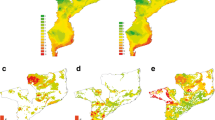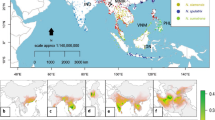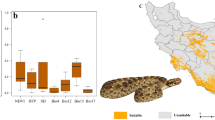Abstract
Snakebite envenoming is an important public health concern worldwide. In the Americas, ~300,000 bites occur annually, leaving 84,110–140,981 envenomings and 652–3466 deaths. Here, we modeled current and future snakebite risk using ecological niche models (ENMs) of 90 venomous snake taxa. Current snakebite risk predictions were corroborated by incidence data from eight regions/periods with different characteristics. Detailed projections of potential future range shifts on distributions of the medically most relevant species indicated that North American species’ ranges are likely to increase in the future, but mixed results were obtained for Latin American snakes. A likely expansion of overall risk area and an increase of rural population at risk were observed from a consensus model among future scenarios. Our study highlights the capacity of ENMs to provide detailed information on current and future potential distributions of venomous snakes, as well as useful perspectives on snakebite risk, at least broad scales.






Similar content being viewed by others
References
Araújo MB, New M (2007) Ensemble forecasting of species distributions. Trends Ecol Evol 22:42–47
Araújo MB, Peterson AT (2012) Uses and misuses of bioclimatic envelope modeling. Ecology 93:1527–1539
Araújo MB, Thuiller W, Pearson RG (2006) Climate warming and the decline of amphibians and reptiles in Europe. J Biogeogr 33:1712–1728
Barbosa AM, Brown JA, Real R (2014) modEvA – an R package for model evaluation and analysis. R package, version 0.1. http://www.r-project.org/cran
Barve N (2008) Tool for Partial-ROC, ver 1.0. Biodiversity Institute, Lawrence, KS
Barve N, Barve V (2013) ENMGadgets: tools for pre and post processing in ENM workflows; https://github.com/vijaybarve/ENMGadgets
Barve N et al. (2011) The crucial role of the accessible area in ecological niche modeling and species distribution modeling. Ecol Model 222:1810–1819
Boria RA, Olson LE, Goodman SM, Anderson RP (2014) Spatial filtering to reduce sampling bias can improve the performance of ecological niche models. Ecol Model 275:73–77
Campbell JA, Lamar WW (2004) The venomous reptiles of the western hemisphere. Cornell University Press, Ithaca
Campbell LP, Luther C, Moo-Llanes D, Ramsey JM, Danis-Lozano R, Peterson AT (2015) Climate change influences on global distributions of dengue and chikungunya virus vectors. Philos Trans R Soc B 370:20140135
Center for International Earth Science Information Network (CIESIN), Columbia University; United Nations Food and Agriculture Programme (FAO); and Centro Internacional de Agricultura Tropical (CIAT) (2005) Gridded Population of the World: Future Estimates (GPWFE). Palisades, NY: Socioeconomic Data and Applications Center (SEDAC), Columbia University. http://sedac.ciesin.columbia.edu/gpw
Chippaux JP (2008) Estimating the global burden of snakebite can help to improve management. PLoS Med 5:e221
Chippaux JP (2012) Epidemiology of snakebites in Europe: a systematic review of the literature. Toxicon 59:86–99
Cruz LS, Vargas R, Lopes AA (2009) Snakebite envenomation and death in the developing world. Ethn Dis 19:42
da Fonseca GA et al. (2000) Following Africa’s lead in setting priorities. Nature 405:393–394
Diniz-Filho JAF, Mauricio Bini L, Fernando Rangel T, Loyola RD, Hof C, Nogués-Bravo D, Araújo MB (2009) Partitioning and mapping uncertainties in ensembles of forecasts of species turnover under climate change. Ecography 32:897–906
Elith J, Phillips SJ, Hastie T, Dudík M, Chee YE, Yates CJ (2011) A statistical explanation of MaxEnt for ecologists. Divers Distrib 17:43–57
Ellis, E.C., K.K. Goldewijk, S. Siebert, D. Lightman, and N. Ramankutty (2013) Anthropogenic Biomes of the World, Version 2, 2000. Palisades, NY: NASA Socioeconomic Data and Applications Center (SEDAC). http://sedac.ciesin.columbia.edu/data/set/anthromes-anthropogenic-biomes-world-v2-2000
Feeley KJ, Silman MR (2011) The data void in modeling current and future distributions of tropical species. Glob Chang Biol 17:626–630
Fielding AH, Bell JF (1997) A review of methods for the assessment of prediction errors in conservation presence/absence models. Environ Conserv 24:38–49
Guisan A, Zimmermann NE (2000) Predictive habitat distribution models in ecology. Ecol Model 135:147–186
Gutiérrez JM, Williams D, Fan HW, Warrell DA (2010) Snakebite envenoming from a global perspective: towards an integrated approach. Toxicon 56:1223–1235
Hansson E, Cuadra S, Oudin A, de Jong K, Stroh E, Torén K, Albin M (2010) Mapping snakebite epidemiology in Nicaragua-pitfalls and possible solutions. PLoS Negl Trop Dis 4:e896
Hansson E, Sasa M, Mattisson K, Robles A, Gutiérrez JM (2013) Using geographical information systems to identify populations in need of improved accessibility to antivenom treatment for snakebite envenoming in Costa Rica. PLoS Negl Trop Dis 7:e2009
Hickling R, Roy DB, Hill JK, Fox R, Thomas CD (2006) The distributions of a wide range of taxonomic groups are expanding polewards. Glob Chang Biol 12:450–455
Hijmans RJ, Van Etten J (2010) raster: geographic analysis and modeling with raster data - R package version 1.3–11. http://www.r-project.org/cran
Hijmans RJ, Guarino L, Bussink C, Mathur P, Cruz M, Barrantes I, Rojas E (2004) DIVA-GIS, version 4: geographic information system for the analysis of biodiversity data. Manual. http://www.diva-gis.org
Hijmans RJ, Cameron SE, Parra JL, Jones PG, Jarvis A (2005) Very high resolution interpolated climate surfaces for global land areas. Int J Climatol 25:1965–1978
Hijmans RJ, Phillips SJ, Leathwick J, Elith J (2011) dismo: species distribution modeling - R package version 0.7–17. http://www.r-project.org/cran
Huey RB, Deutsch CA, Tewksbury JJ, Vitt LJ, Hertz PE, Álvarez-Pérez HJ, Garland T (2009) Why tropical forest lizards are vulnerable to climate warming. Proc R Soc B 276:1939–1948
Kasturiratne A et al. (2008) The global burden of snakebite: a literature analysis and modelling based on regional estimates of envenoming and deaths. PLoS Med 5:1591–1604
Küper W, Sommer J, Lovett J, Barthlott W (2006) Deficiency in African plant distribution data–missing pieces of the puzzle. Bot J Linn Soc 150:355–368
Leynaud GC, Reati GJ (2009) Identifying areas of high risk for ophidism in Cordoba, Argentina, using SIGEpi software. Rev Panam Salud Publica 26:64–69
Lobo JM, Jiménez-Valverde A, Real R (2007) AUC: a misleading measure of the performance of predictive distribution models. Glob Ecol Biogeogr 17:145–151
Martínez-Meyer E, Díaz-Porras DF, Peterson AT, Yañez-Arenas C (2013) Ecological niche structure and rangewide abundance patterns of species. Biol Lett 9:20120637
Moreno-Rueda G, Pleguezuelos JM, Pizarro M, Montori A (2012) Northward shifts of the distributions of Spanish reptiles in association with climate change. Conserv Biol 26:278–283
Nori J, Carrasco PA, Leynaud GC (2014) Venomous snakes and climate change: ophidism as a dynamic problem. Clim Chang 122:67–80
O’Neil ME, Mack KA, Gilchrist J, Wozniak EJ (2007) Snakebite injuries treated in United States emergency departments, 2001–2004. Wilderness Environ Med 18:281–287
Owens HL, Campbell LP, Dornak LL, Saupe EE, Barve N, Soberón J, Peterson AT (2013) Constraints on interpretation of ecological niche models by limited environmental ranges on calibration areas. Ecol Model 263:10–18
Parmesan C, Yohe G (2003) A globally coherent fingerprint of climate change impacts across natural systems. Nature 421:37–42
Parrish HM (1966) Incidence of treated snakebites in the United States. Public Health Rep 81:269–276
Pearson RG, Dawson TP (2003) Predicting the impacts of climate change on the distribution of species: are bioclimate envelope models useful? Glob Ecol Biogeogr 12:361–371
Peterson AT, Ortega-Huerta MA, Bartley J, Sánchez-Cordero V, Soberón J, Buddemeier RH, Stockwell D (2002) Future projections for Mexican faunas under global climate change scenarios. Nature 416:626–629
Peterson AT, Papeş M, Soberón J (2008) Rethinking receiver operating characteristic analysis applications in ecological niche modelling. Ecol Model 213:63–72
Phillips SJ, Anderson RP, Schapire RE (2006) Maximum entropy modeling of species geographic distributions. Ecol Model 190:231–259
Platts PJ, Garcia RA, Hof C, Foden W, Hansen LA, Rahbek C, Burgess ND (2014) Conservation implications of omitting narrow-ranging taxa from species distribution models, now and in the future. Divers Distrib 20:1307–1320
R Development Core Team (2012) R: a language and environment for statistical computing. Version 2.15.1. http://cran.R-project.org. R Foundation for Statistical Computing, Vienna
Sokal RR, Rohlf FJ (1995) Biometry. W. H. Freeman
Stock RP, Massougbodji A, Alagón A, Chippaux JP (2007) Bringing antivenoms to sub-Saharan Africa. Nat Biotechnol 25:173–177
Stockwell D, Peterson AT (2002) Effects of sample size on accuracy of species distribution models. Ecol Model 148:1–13
Taylor KE, Stouffer RJ, Meehl GA (2012) An overview of CMIP5 and the experiment design. B Am Meteorol Soc 93:485–498
Thomas CD et al. (2004) Extinction risk from climate change. Nature 427:145–148
Thuiller W, Lavorel S, Araújo MB, Sykes MT, Prentice IC (2005) Climate change threats to plant diversity in Europe. Proc Natl Acad Sci U S A 102:8245–8250
Tingley MW, Koo MS, Moritz C, Rush AC, Beissinger SR (2012) The push and pull of climate change causes heterogeneous shifts in avian elevational ranges. Glob Chang Biol 18:3279–3290
Warrell D (2010) Snake bite. Lancet 375:77–88
Warren DL (2012) In defense of ‘niche modeling’. Trends Ecol Evol 27:497–500
WHO (2009) Neglected tropical diseases: snakebite. http://www.who.int/neglected_diseases/diseases/snakebites/en/index.html. Accessed 15 April 2014
Williams D, Gutiérrez JM, Harrison R, Warrell DA, White J, Winkel KD, Gopalakrishnakone P (2010) The global snake bite initiative: an antidote for snake bite. Lancet 375:89–91
WWF (2006) Conservation Science Ecoregions. http://www.worldwildlife.org/science/ecoregions. Accessed 21 July 2014
Yañez-Arenas C, Peterson AT, Mokondoko P, Rojas-Soto O, Martínez-Meyer E (2014) The use of ecological niche modeling to infer potential risk areas of snakebite in the Mexican state of Veracruz. PLoS One 9:e100957
Acknowledgments
We thank CONACYT for support the postdoctoral studies of Carlos Yañez-Arenas at the University of Kansas. Andrés Lira, Rafe Brown, Lindsay Campbell, Jorge Soberón, Enrique Martínez-Meyer, and Abdallah Samy provided valuable comments and discussion.
Author information
Authors and Affiliations
Corresponding author
Rights and permissions
About this article
Cite this article
Yañez-Arenas, C., Townsend Peterson, A., Rodríguez-Medina, K. et al. Mapping current and future potential snakebite risk in the new world. Climatic Change 134, 697–711 (2016). https://doi.org/10.1007/s10584-015-1544-6
Received:
Accepted:
Published:
Issue Date:
DOI: https://doi.org/10.1007/s10584-015-1544-6




